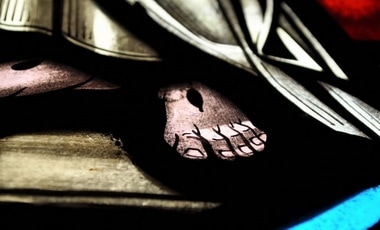The Shroud Evidences – Dr. Johnston
(March 29, 2024) Is there enough evidence to prove that the Shroud of Turin is real? Prestonwood Baptist Church apologetics pastor Jeremiah Johnston used to be a skeptic. But once he did a deep dive into the history of the Shroud, he became a “total defender” of the Shroud’s authenticity. This Easter Week, Pastor Johnston joins the Glenn Beck Program to lay it all out from a scientific perspective. Plus, he explains why you don’t need to be Catholic to believe the Shroud is truly the burial cloth of Jesus Christ.
- (John 20:5-8, CSB) 5Stooping down, he saw the linen cloths lying there, but he did not go in. 6 Then, following him, Simon Peter also came. He entered the tomb and saw the linen cloths lying there. 7 The wrapping that had been on his head was not lying with the linen cloths but was folded up in a separate place by itself. 8 The other disciple, who had reached the tomb first, then also went in, saw, and believed.
The indomitable Leon Morris:
6–7 It is not said how much later Peter arrived. But when he got there he did not hesitate but went straight into the tomb. He saw the cloths that had been around the body. John specifically mentions that the cloth that had been on Jesus’ head was not with the others, but was wrapped up in a place of its own (Berkeley [Berkeley The Holy Bible, The Berkeley Version (Grand Rapids, 1959)] renders “in its particular place,” but this seems to go beyond the meaning of the Greek). In recent years this has often been taken to mean that the grave clothes were just as they had been when placed around the body. That is to say, Jesus’ body rose through the grave-clothes without disturbing them. This is not inconsistent with the language, but we should bear in mind that John does not say this. That the headcloth18 was not with the others scarcely supports the view, for had this been the case it would have been right alongside them, with no more than the length of the neck (if that) between them. Moreover, “folded up” does not look like a description of the way it would have appeared if the head had simply passed through it. However, whatever be the truth of this, John is plainly describing an orderly scene, not one of wild confusion. This means that the body had not been taken by grave robbers. They would never have left the cloths wrapped neatly. They would have taken the body, cloths and all, or would have taken the cloths off and dropped them in a heap.19 [1]
18 σουδάριον is a loanword from the Latin sudarium, a cloth for wiping off sweat (sudor); it denotes a cloth more or less like our handkerchief. Here it apparently signifies a jawband, a cloth that went “round the face and over the head” (Robinson, Priority, p. 292) to hold the jaw in position.
19 Long ago Chrysostom remarked: “For neither, if any persons had removed the body, would they before doing so have stripped it; nor if any had stolen it, would they have taken the trouble to remove the napkin, and roll it up, and lay it in a place by itself; but how? they would have taken the body as it was. On this account John tells us by anticipation that it was buried with much myrrh, which glues linen to the body not less firmly than lead …” (85.4; pp. 320–21). Grave robbing was regarded as a serious offense; Barrett cites an ordinance of Claudius prescribing capital punishment for offenders (The New Testament Background: Selected Documents [London, 1957], p. 15).
[1] Leon Morris, The Gospel according to John, The New International Commentary on the New Testament (Grand Rapids, MI: Wm. B. Eerdmans Publishing Co., 1995), 735.
The Shroud Evidences – Mr. Schwortz
(July 30, 2023) Is the debate over the Shroud of Turin over? Many Christians believe it was the burial cloth of Jesus and even non-Christian scientists struggle to explain how the image of a man was imposed onto it. But some scientists have claimed that carbon dating has proven it is much younger than previously thought. However, Shroud of Turin Research Project Official Photographer Barrie Schwortz joins Glenn to explain why he’s refuting that claim. According to Schwortz, who was once a “total skeptic” of the Shroud, the carbon dating was improperly done. Instead, he believes the most plausible explanation is simple: “This is the burial shroud of the historic Jesus of Nazareth.”
The NEW YORK POST updates the issue a bit with [of course] an A.I. rendering:
New X-ray analysis seems to prove that the Shroud of Turin was indeed from Jesus Christ’s time – allowing artificial intelligence to recreate stunning images of what many believe could be Christ himself.
Christians have long believed that the treasured relic was the burial cloth of Jesus, showing an imprint of their Messiah’s face.
While dating analysis from the 1980s suggested it was actually a painted forgery from the 1300s, new X-ray dating evaluation suggests it was from 2,000 years ago, putting it in Christ’s time, according to a study published in the Heritage journal.
That knowledge has since allowed cutting-edge artificial intelligence (AI) technology to creating vivid, eerily lifelike renderings of the facial impression that believers are convinced was left on the cloth at the moment of Christ’s resurrection.
One image drawn from the facial imprint by AI site Midjourney was eerily similar to many classical art historical depictions of Jesus, including the shoulder-length hair and beard.
The AI image also shows the man with wounds on his bare chest, suggesting that he had just been tortured and killed, noted the Daily Express, which generated the image.
[….]
Dr. Liberato de Caro, the leader of the Heritage analysis, claimed that the wide-angle X-ray analysis proved that the Shroud of Turin matched a similar fabric sample from Masada, Israel dating between 55 to 74 CE.
“The experimental results are compatible with the hypothesis that the Turin Shroud is a 2000-year-old relic,” the study said, claiming that the previous definitive analysis was flawed due to contamination.
There were also tiny particles of pollen from the Middle East lodged in the linen fibers of the shroud, which seemingly ruled out the idea that the fabric came from Europe, Dr. de Caro added. …
Of course, there are other A.I. renderings of the image, and they vary in appearance. So know that man-made parameters for the programs change the end result — in other words, the images may be close, but no cigar.
My dad had this same painting hanging in his hallway. The eyes are painted shut, but it also loos like he is staring at you:
Spooky Jesus
… Uhm … I would much rather have the A.I. renderings than this.
Note that Doc Habermas talks about the “teeth image” that makes the accurate image of God
The Shroud Evidences – Dr. Habermas
Dr. Gary Habermas shares the special qualities of the Shroud of Turin and problems with the most recent Carbon 14 dating.
The Resurrection Evidences – Dr. Craig





